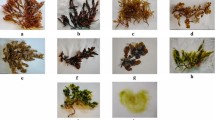Abstract
Objective
Heterocapsa triquetra (H. triquetra) is classified as bloom-forming dinoflagellate. Early detection is needed to prevent damage by them in the field. Cells of H. triquetra are more difficult to break than bacteria or animal cells because their cells are covered by amorphous cellulose. Therefore, it is necessary to manufacture algae specific buffer that can easily and quickly lyse H. triquetra.
Methods
In the present study, we made lysis buffer to extract DNA and protein from H. triquetra with treatment at room temperature for several minutes. As a result, H. triquetra cells were lysed and dual quantification of DNA and protein could be performed. To confirm DNA extraction, internal transcribed spacer (ITS) region PCR was performed. For protein extraction, SDS-PAGE followed by silver staining and ATPase activity test were used.
Results
Results showed that lysis buffer containing 1.0–5.0% of SDS was efficient for gDNA and protein extraction. The presence of 1 mM EDTA in the buffer was key factor affecting cell wall loosening during H. triquetra cell lysis.
Conclusion
Our MDE method is rapid and simple. It is useful for other microalgae studies.
Similar content being viewed by others
References
Nosrati-Ghods, N., Ghadiri, M. & Fruh, W. G. Management and environmental risk study of the physicochemical parameters of ballast water. Mar. Pollut. Bull. 114, 428–438, doi: https://doi.org/10.1016/j.marpolbul.2016.09.062 (2017).
Tsolaki, E. & Diamadopoulos, E. Technologies for ballast water treatment: a review. J. Chem. Technol. Biotechnol. 85, 19–32, doi: https://doi.org/10.1002/jctb.2276 (2009).
Lindholm, T. & Nummelin, C. Red tide of the dinoflagellate Heterocapsa triquetra (Dinophyta) in a ferry-mixed coastal inlet. Hydrobiologia 393, 245–251 (1999).
Tillmann, U., Hoppenrath, M., Gottschling, M., Kusber, W. H. & Elbrachter, M. Plate pattern clarification of the marine dinophyte Heterocapsa triquetra sensu Stein (Dinophyceae) collected at the Kiel Fjord (Germany). J. Phycol. 53, 1305–1324, doi: https://doi.org/10.1111/jpy.12584 (2017).
Jagielski, T. et al. An optimized method for high quality DNA extraction from microalga Prototheca wickerhamii for genome sequencing. Plant Methods 13, 77, doi: https://doi.org/10.1186/s13007-017-0228-9 (2017).
Yang, J. L. et al. A simple and rapid method for extracting bacterial DNA from intestinal microflora for ERIC-PCR detection. World J. Gastroenterol. 14, 2872–2876 (2008).
Penna, A. & Galluzzi, L. The quantitative real-time PCR applications in the monitoring of marine harmful algal bloom (HAB) species. Environ. Sci. Pollut. Res. Int. 20, 6851–6862, doi: https://doi.org/10.1007/s11356-012-1377-z (2013).
Mamedov, T. & Yusibov, V. Green algae Chlamydomonas reinhardtii possess endogenous sialylated N-glycans. FEBS Open Bio 1, 15–22, doi: https://doi.org/10.1016/j.fob.2011.10.003 (2011).
Rouxel, C., Daniel, A., Jérôme, M., Etienne, M. & Fleurence, J. Species identification by SDS-PAGE of red algae used as seafood or a food ingredient. Food Chem. 74, 349–353 (2001).
Hadi, S. I. et al. DNA Barcoding Green Microalgae Isolated from Neotropical Inland Waters. PloS One 11, e0149284, doi: https://doi.org/10.1371/journal.pone.0149284 (2016).
Shafa, F. & Salton, M. R. Disaggregation of bacterial cell walls by anionic detergents. J. Gen. Microbiol. 23, 137–141, doi: https://doi.org/10.1099/00221287-23-1-137 (1960).
Tsugama, D., Liu, S. & Takano, T. A rapid chemical method for lysing Arabidopsis cells for protein analysis. Plant Methods 7, 22, doi: https://doi.org/10.1186/1746-4811-7-22 (2011).
Schoch, C. L. et al. Nuclear ribosomal internal transcribed spacer (ITS) region as a universal DNA barcode marker for Fungi. Proc. Natl. Acad. Sci. U.S.A. 109, 6241–6246, doi: https://doi.org/10.1073/pnas.1117018109 (2012).
Mai, J. C. & Coleman, A. W. The internal transcribed spacer 2 exhibits a common secondary structure in green algae and flowering plants. J. Mol. Evol. 44, 258–271 (1997).
Jaqueline S. & Heeg, M. ITS2 and 18S rDNA sequence-structure phylogeny of Chlorella and allies (Chlorophyta, Trebouxiophyceae, Chlorellaceae). Plant Gene. 4, 20–28 (2015).
Zou, S. et al. How DNA barcoding can be more effective in microalgae identification: a case of cryptic diversity revelation in Scenedesmus (Chlorophyceae). Sci. Rep. 6 (2016).
Elferink, J. G. The effect of ethylenediaminetetraacetic acid on yeast cell membranes. Protoplasma 80, 261–268 (1974).
Acknowledgements
This work was carried out with the support of “Cooperative Research Program for Agriculture Science & Technology Development (PJ011661)” funded by Rural Development administration, Republic of Korea. This research was also supported by Basic Science Research Program through the National Research Foundation of Korea (NRF) funded by the Ministry of Science, ICT & Future Planning (NRF-2017R1A2B4012253).
Author information
Authors and Affiliations
Corresponding authors
Electronic supplementary material
Rights and permissions
About this article
Cite this article
Ahn, G., Park, GY., Park, DY. et al. Microalgae Direct Extract Reagent for Heterocapsa triquetra. Toxicol. Environ. Health Sci. 11, 73–78 (2019). https://doi.org/10.1007/s13530-019-0390-8
Received:
Revised:
Accepted:
Published:
Issue Date:
DOI: https://doi.org/10.1007/s13530-019-0390-8




